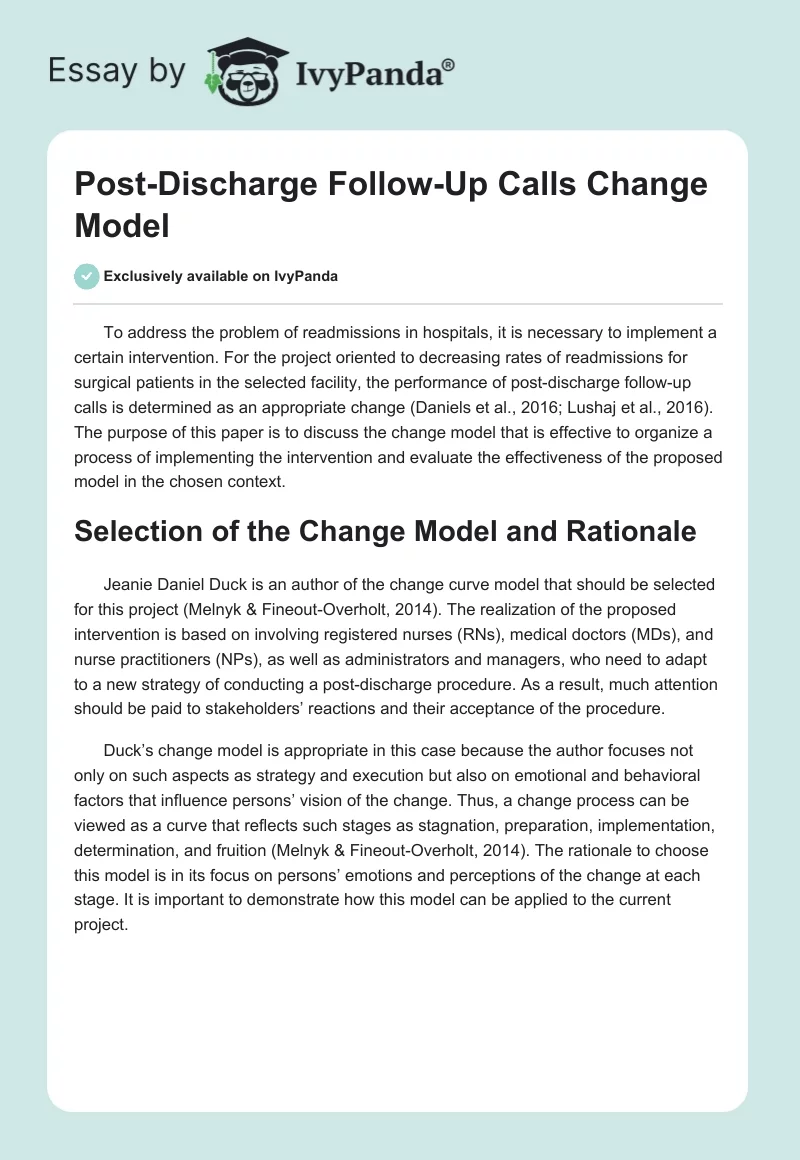To address the problem of readmissions in hospitals, it is necessary to implement a certain intervention. For the project oriented to decreasing rates of readmissions for surgical patients in the selected facility, the performance of post-discharge follow-up calls is determined as an appropriate change (Daniels et al., 2016; Lushaj et al., 2016). The purpose of this paper is to discuss the change model that is effective to organize a process of implementing the intervention and evaluate the effectiveness of the proposed model in the chosen context.
Selection of the Change Model and Rationale
Jeanie Daniel Duck is an author of the change curve model that should be selected for this project (Melnyk & Fineout-Overholt, 2014). The realization of the proposed intervention is based on involving registered nurses (RNs), medical doctors (MDs), and nurse practitioners (NPs), as well as administrators and managers, who need to adapt to a new strategy of conducting a post-discharge procedure. As a result, much attention should be paid to stakeholders’ reactions and their acceptance of the procedure.
Duck’s change model is appropriate in this case because the author focuses not only on such aspects as strategy and execution but also on emotional and behavioral factors that influence persons’ vision of the change. Thus, a change process can be viewed as a curve that reflects such stages as stagnation, preparation, implementation, determination, and fruition (Melnyk & Fineout-Overholt, 2014). The rationale to choose this model is in its focus on persons’ emotions and perceptions of the change at each stage. It is important to demonstrate how this model can be applied to the current project.
The Change Model in Relation to the Implementation Plan
The first stage of the change model is stagnation which determines problems in the currently used strategy (Melnyk & Fineout-Overholt, 2014). In this project, the phase of stagnation is associated with the period of increasing readmission rates that cannot be addressed effectively and that cause the use of more human and financial resources to readmit all surgical patients. At the second stage of preparation, it is important to formulate a plan of actions, develop a procedure for performing follow-up calls, assign RNs, MDs, and NPs to perform these calls, and improve the practitioners’ schedule.
At this stage, RNs, MDs, and NPs can demonstrate the unwillingness to perform unfamiliar tasks, and it is important to support them in order to continue the change project (Clari et al., 2015; Szöts, Konradsen, Solgaard, & Østergaard, 2014). Implementation is the third stage, and it is the most critical one because, according to Duck, one group of employees will accept the change and perform tasks, but the level of enthusiasm can be low. The second group will discuss changes as inappropriate, and the third group will resist them (Melnyk & Fineout-Overholt, 2014). In the context of this project, it is important to communicate with different groups of RNs, MDs, and NPs, educate employees regarding positive outcomes, and support their attempts to perform follow-up calls efficiently.
The specifics of the proposed change project mean that there will be two groups of employees: those who follow a new post-discharge procedure while working with a test group of patients and those who do not perform telephone calls because of working with a control group. As a result, at the stage of determination, it is possible to observe the fatigue among RNs, MDs, and NPs who act according to new rules, but they cannot assess the results of their activities (Hornick, Balderman, Eugea, Sanchez, & Zayed, 2016). To avoid stagnation, it is important to communicate with employees and encourage them to participate in the project. The final stage is fruition, and at this stage, RNs, MDs, NPs, and managers are expected to observe positive outcomes of their work in terms of decreasing readmission rates. However, at this stage, it is necessary to help other employees accept the principles of a new procedure.
Conclusion
Duck’s change model based on the analysis of actors’ emotions, attitudes, and fears is effective to be used in order to implement change projects because of the focus on employees’ visions and perceptions that can be addressed by managers. The leaders’ immediate action directed to assisting RNs, MDs, and NPs in their performance of new responsibilities is an appropriate response to the risk of fears, rejection, and stagnation. The model is usually presented in the form of a curve. It is important to focus on this curve within a conceptual model while analyzing the results of the project (Appendix A).
References
Clari, M., Frigerio, S., Ricceri, F., Pici, A., Alvaro, R., & Dimonte, V. (2015). Follow‐up telephone calls to patients discharged after undergoing orthopaedic surgery: Double‐blind, randomized controlled trial of efficacy. Journal of Clinical Nursing, 24(19), 2736-2744. Web.
Daniels, S. A., Kelly, A., Bachand, D., Simeoni, E., Hall, C., Hofer, S. M., & Hayashi, A. (2016). Call to care: The impact of 24-hour postdischarge telephone follow-up in the treatment of surgical day care patients. The American Journal of Surgery, 211(5), 963-967. Web.
Hornick, J. R., Balderman, J. A., Eugea, R., Sanchez, L. A., & Zayed, M. A. (2016). A telephone call 1 week after hospitalization can identify risk factors for vascular surgery readmission. Journal of Vascular Surgery, 64(3), 719-725. Web.
Lushaj, E. B., Nelson, K., Amond, K., Kenny, E., Badami, A., & Anagnostopoulos, P. V. (2016). Timely post-discharge telephone follow-up is a useful tool in identifying post-discharge complications patients after congenital heart surgery. Pediatric Cardiology, 37(6), 1106-1110. Web.
Melnyk, B. M., & Fineout-Overholt, E. (2014). Evidence-based practice in nursing and healthcare: A guide to best practice. Philadelphia, PA: Lippincott Williams & Wilkins.
Szöts, K., Konradsen, H., Solgaard, S., & Østergaard, B. (2014). Telephone follow-up by nurse following total knee arthroplasty-protocol for a randomized clinical trial. BMC Nursing, 13(1), 1-8. Web.


